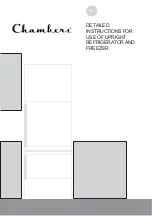
14
PROBLEM SOLVER
First try the solutions suggested here or visit our website and reference FAQs (Frequently Asked Questions)
to possibly avoid the cost of a service call.
In the U.S.A., www.whirlpool.com
Electrical Shock Hazard
Plug into a grounded 3 prong outlet.
Do not remove ground prong.
Do not use an adapter.
Do not use an extension cord.
Failure to follow these instructions can result in death,
fire, or electrical shock.
WARNING
WARNING
Explosion Hazard
Use nonflammable cleaner.
Failure to do so can result in death, explosion, or fire.
If you experience
Possible Causes and/or Recommended Solutions
The refrigerator
will not operate
■
Not connected to an electrical supply - Plug the power cord into a grounded 3-prong outlet. Do not use
an extension cord.
■
No power to the electrical outlet - Plug in a lamp to see if the outlet is working.
■
Household fuse blown or circuit breaker tripped - Replace the fuse or reset the circuit breaker. If the
problem continues, contact an electrician.
■
Control is not turned on - Turn the refrigerator control on.
■
New Installation - Allow 24 hours following installation for the refrigerator to cool completely.
NOTE: Adjusting the temperature control(s) to coldest setting will not cool the refrigerator more quickly.
The motor seems
to run too much
Your new refrigerator may run longer than your old one. Energy efficient refrigerators run longer at lower, more
energy efficient speeds. Your refrigerator may run even longer if the room is warm, a large food load is added,
the door is opened often, or if the door has been left open.
The refrigerator is
noisy
Refrigerator noise has been reduced over the years. Due to this reduction in operating noise, you may notice
unfamiliar noises that are normal. Following are some normal sounds with an explanation:
■
Buzzing - heard when the water valve opens to fill the ice maker
■
Clicking/Snapping - valves opening or closing
■
Pulsating - fans/compressor adjusting to optimize performance
■
Rattling - flow of refrigerant, water line, or from items placed on top of the refrigerator
■
Sizzling/Gurgling - water dripping on the heater during defrost cycle
■
Popping - contraction/expansion of inside walls, especially during initial cool-down
■
Water running - may be heard when ice melts during the defrost cycle and water runs into the drain pan
■
Creaking/Cracking - occurs as ice is being ejected from the ice maker mold.
The door will not
close completely
■
The door is blocked open - Move food packages away from door. Push bin or shelf back into the correct
position. Make sure the crisper cover is fully pushed in, so that the back rests on the supports.
The door is
difficult to open
■
Gaskets are dirty or sticky - Clean gaskets and contact surfaces with mild soap and warm water. Rinse
and dry with soft cloth.
Summary of Contents for WRT111SFDB
Page 35: ...35 ...















































